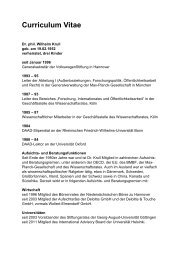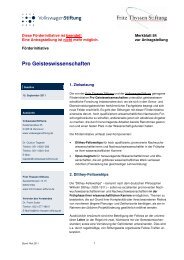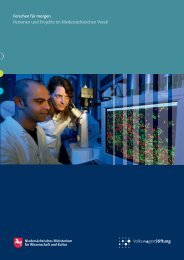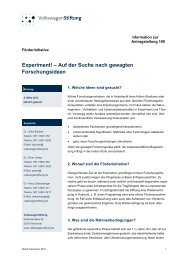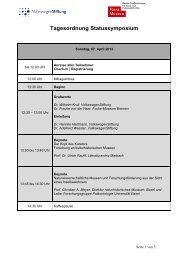Funding
Funding
Funding
Create successful ePaper yourself
Turn your PDF publications into a flip-book with our unique Google optimized e-Paper software.
30<br />
<strong>Funding</strong> initiative<br />
“Lichtenberg Professorships”<br />
– see page 66<br />
“Soft matter” is the central topic, even on the<br />
staircase: (from the left) Kerstin Schindler<br />
(chemist), Heiko Schoberth (physicist), Petra<br />
Zippelius, Anne Horn (chemist), Dr. Li-Tang<br />
Yan, Dr. Sujit Kumar Gosh and Gonther Jutz<br />
(chemist) make up the team around Professor<br />
Dr. Alexander Böker (foreground).<br />
By means of his fine synthetic membranes with nanopores of a defined size,<br />
he is pursuing the goal of producing tiny containers, vehicles in which cells<br />
or medicaments can be encapsulated. One concrete application he is working<br />
on – together with cooperation partners – is the treatment of the autoimmune<br />
disease type I diabetes mellitus. This disease occurs in diabetics, when the<br />
sick person’s own immune system attacks and destroys cells that produce the<br />
vital insulin. If Alexander Böker is successful in shutting insulin-producing<br />
cells in his revolutionary capsules, these can then be embedded into the patient’s<br />
pancreas, where they can then discharge their contents. “The size of the pores<br />
in the membranes we are experimenting with can be defined so exactly that<br />
the attacking cells released by the patient’s immune system cannot get through<br />
– thus shielding the process of insulin production.” This could lead to a cure<br />
for diabetics.<br />
The researcher intends to encapsulate not only cells but also drugs. It would be<br />
most unlike a Lichtenberg Professor to stop at only one application for a new<br />
discovery. No, his capsules must also be capable of being “activated”. Encapsulated<br />
in his new membranes, he also wants to transport drugs – against cancer<br />
for instance. And these should not be released until once inside the tumor.<br />
How does he intend to achieve this? Alexander Böker is in his element as he<br />
explains how he wants to design his pores to have functions, e.g. to open up<br />
like an automatic door when activated by an external chemical signal. In certain<br />
types of tumor, it might be possible to trigger such a function by means<br />
of a very slight shift in the acidity level within the tissue: This would cause<br />
the chemical barriers in the pores to contract, forming a sort of spiral, and<br />
thereby opening the container. Vision? Yes – but a rather plausible one.






